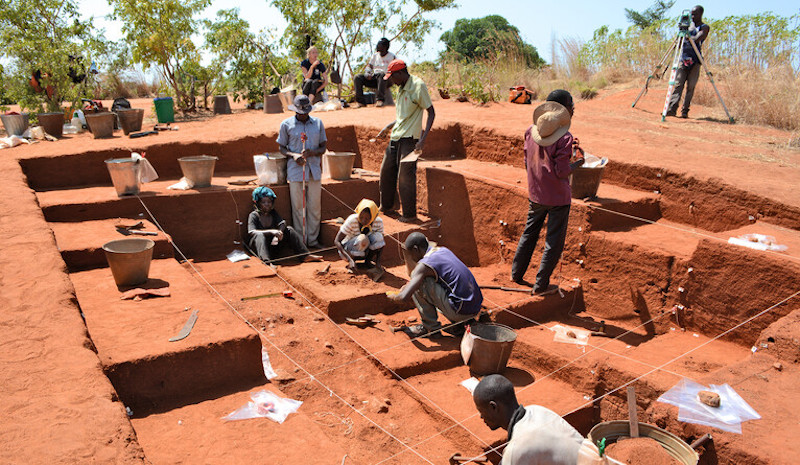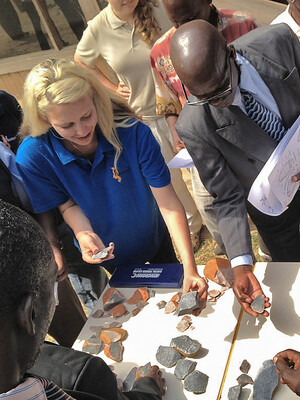Mastery of fire by early humans provided warmth, light, protection from predators, a way to cook food and make stronger hunting tools. There’s evidence that humans used fire in these ways as far back as 2 million years ago. On May 5, 2021, a team of scientists announced new research from the northern shores of Lake Malawi in eastern Africa, providing the earliest evidence to date of a more subtle – but equally powerful – form of human mastery over fire. Part of the evidence is archeological, dense clusters of stone artifacts dating as far back as 92,000 years ago. Part is paleoenvironmental, from sediments drawn from the lake. The combined findings document that early humans in this region were ecosystem engineers, these scientists said, who used fire to prevent regrowth of the region’s forests. In place of the forest, these early people created a sprawling bushland, attractive to wildlife that could be hunted for food. This bushland still exists today.
Yale University paleoanthropologist Jessica Thompson is lead author of the study, which the scientists said is the earliest evidence to date of ancient humans significantly altering entire ecosystems with fire. She said:
We were expecting the environment and the climate to have influenced the people, but really what we found was that it was people who were influencing their environments.
The study was published May 5, 2021, in the peer-reviewed journal Science Advances.


Thompson commented in The Conversation:
We are part of an interdisciplinary collaboration between archaeologists who study past human behavior, geochronologists who study the timing of landscape change and paleoenvironmental scientists who study ancient environments. By combining evidence from these research specialities, we have identified an instance in the very distant past of early humans bending environments to suit their needs. In doing so, they transformed the landscape around them in ways still visible today.
Thompson and her team had logged several field seasons of archaeological work in the region before striking up a dialog with a team of paleoenvironmentalists doing research nearby, in the lakebed. That teamwork ultimately helped them make sense of the patterns they observed in their data. The researchers discovered that the regional archaeological record, its ecological changes, and the development of alluvial fans near Lake Malawi — an accumulation of sediment eroded from the region’s highland — dated to the same period of origin, suggesting that they were connected. The scientists’ statement explained:
The archaeological data were collected from more than 100 pits excavated across hundreds of kilometers of the alluvial fan that developed during this time of steady lake levels. The paleoenvironmental data are based on counts of pollen and charcoal that settled to the floor of the lakebed and were later recovered in a long sediment core drilled from a modified barge.
Thompson explained:
The mud in the core contains a record of fire history, in the form of tiny fragments of charcoal. Those little flecks told us that around 85,000 years ago, something strange happened around Lake Malawi. Charcoal production spiked, erosion increased and, for the first time in more than half a million years, rainfall did not bring forest recovery.
At the same time this charcoal burst appears in the drill core record, our sites began to show up in the archaeological record – eventually becoming so numerous that they formed one continuous landscape littered with stone tools. Another drill core immediately offshore showed that as site numbers increased, more and more charcoal was washing into the lake. Early humans had begun to make their first permanent mark on the landscape.

According to the researchers, the data revealed that a spike in charcoal accumulation happened shortly before the number of distinct species inhabiting the region dropped. Despite the consistently high lake levels, which imply greater stability in the ecosystem, said the researchers, the species richness went flat following the last arid period based. This was an unexpected result, because over previous climate cycles, rainy environments had produced forests that provide rich habitat for an abundance of species
The increase in archaeological sites after the last arid period, paired with the spike in charcoal and absence of forest, suggests that people were manipulating the ecosystem with fire, the researchers concluded.
Thompson said:
It’s not clear why people were burning the landscape. It’s possible that they were experimenting with controlled burns to produce mosaic habitats conducive to hunting and gathering, a behavior documented among hunter-gatherers. It could be that their fires burned out of control, or that there were simply a lot of people burning fuel in their environment that provided for warmth, cooking, or socialization.
She continued:
One way or another, it’s caused by human activity. It shows early people, over a long period of time, took control over their environment rather than being controlled by it. They changed entire landscapes, and for better or for worse that relationship with our environments continues today.

Bottom line: Stone Age artifacts excavated near the shores of Lake Malawi in eastern Africa, combined with paleoenvironmental data drawn from the lakebed, provides the earliest evidence of ancient humans manipulating their ecosystem with fire.
Source: Early human impacts and ecosystem reorganization in southern-central Africa











